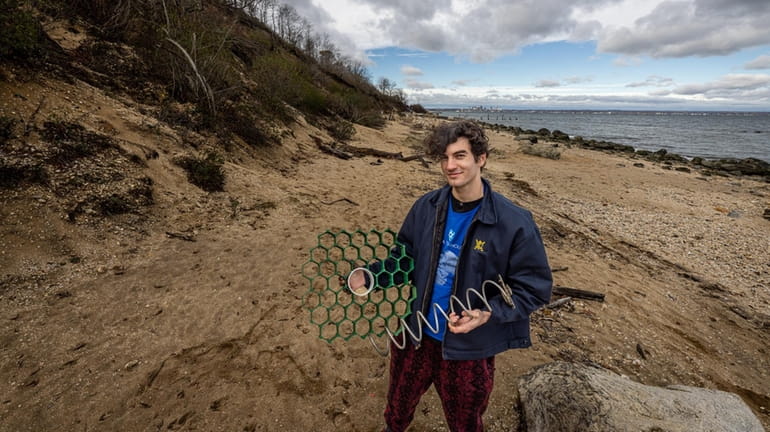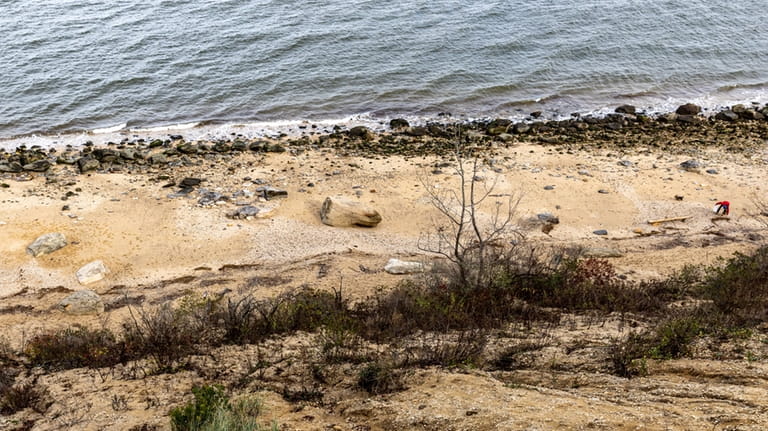Long Island's eroding coast: Tools to stem its loss

Coastal Technologies Corp’s George Thatos holds cliff stablizers used to stop erosion at Sands Point Preserve in Sands Point. Credit: Newsday/J. Conrad Williams Jr.
The best defense against beach erosion often is simple and low-tech: native grasses and other plants that help hold sand in place and blunt the force of the waves. But a lot of Long Island’s coastal grasses already have been lost to erosion, development and pollution, and once they’re gone it can be tough to bring them back, experts say.
A Long Island startup and a team of engineers at Stony Brook University are experimenting with tools to give plants a solid foothold.
Coastal Technologies Corp., founded in 2021 by the father and son team Nicholas and George Thatos, has developed a series of products designed to mitigate coastal erosion. In September 2022, Coastal installed a line of honeycomb grids on the face of a bluff at the Sands Point Preserve on Hempstead Bay, each affixed with a metal corkscrew stake. In each pocket of the grid, Coastal planted deep-rooted beach grass, with hardy native shrubs — bayberry, beach plum and beach rose — alongside.
The day after the plants were installed, Hurricane Ian whipped through. All the control plants — placed outside the grids — washed away, and the soil on the whole bluff eroded by four inches. But in the test plot, all the seedlings and the surrounding soil held, the Thatoses said.
More than a year later, the bluff has eroded another 2 to 4 inches, except in the narrow strip held by the grid.
“The plot has not eroded at all,” Nicholas Thatos said. “The vegetation has thrived, the beach grass has sent out rhizomes, the shrubs have flowered and made fruit.”
The plants reduce runoff, which reduces turbidity in the Sound, and absorb nitrogen which can cause low-oxygen conditions and algal blooms. And the plants were carefully chosen to provide habitat for native insect pollinators and birds.
Once the plants are well established, the grids can be removed and reused. They also could be made from biodegradable materials, such as waxed cardboard or cornstarch-based plastic.
The company has filed a patent for the product.
The Thatoses are also testing tools modeled on grasses and salt marshes that soften the force of ocean waves, capture windblown sediments to help rebuild dunes and provide shelter to newly restored seagrass beds. Their “biomimicry” products don’t look much like grasses — one resembles a long flexible mop, another a squat cylindrical brush — but they serve a similar role. They can be quickly deployed when rough weather is expected and then removed when the threat has passed.
Another idea to fortify coastal soils is percolating at the materials science and chemical engineering department at Stony Brook. There, Dilip Gersappe and Miriam Rafailovich are developing a bio-based polymer that increases the strength and stability of soil. They’ve cultured a type of bacteria that occurs naturally in soil (and so does not introduce anything hazardous into the ecosystem) and has plant-growth superpowers.
“Tiny amounts produce a huge increase in root density,” Gersappe said. So far, the plan is to use these biopolymers to build stronger levees, which can collapse in heavy flooding.
The project is a collaboration with the U.S. Army Corps of Engineers, which provided $9 million in funding over the next four years.
They haven’t tested the material in coastal areas yet, but they hope it can be used to stabilize vulnerable eroding bluffs.
“One of the things we do know is if you put this polymer in the sand, it makes it stronger,” Gersappe said.
The best defense against beach erosion often is simple and low-tech: native grasses and other plants that help hold sand in place and blunt the force of the waves. But a lot of Long Island’s coastal grasses already have been lost to erosion, development and pollution, and once they’re gone it can be tough to bring them back, experts say.
A Long Island startup and a team of engineers at Stony Brook University are experimenting with tools to give plants a solid foothold.
Coastal Technologies Corp., founded in 2021 by the father and son team Nicholas and George Thatos, has developed a series of products designed to mitigate coastal erosion. In September 2022, Coastal installed a line of honeycomb grids on the face of a bluff at the Sands Point Preserve on Hempstead Bay, each affixed with a metal corkscrew stake. In each pocket of the grid, Coastal planted deep-rooted beach grass, with hardy native shrubs — bayberry, beach plum and beach rose — alongside.
The day after the plants were installed, Hurricane Ian whipped through. All the control plants — placed outside the grids — washed away, and the soil on the whole bluff eroded by four inches. But in the test plot, all the seedlings and the surrounding soil held, the Thatoses said.
More than a year later, the bluff has eroded another 2 to 4 inches, except in the narrow strip held by the grid.
“The plot has not eroded at all,” Nicholas Thatos said. “The vegetation has thrived, the beach grass has sent out rhizomes, the shrubs have flowered and made fruit.”

Sea grass, with assistance from cliff stabilizers, grows on the eroded edge of Sands Point Preserve. Credit: Newsday/J. Conrad Williams Jr.
The plants reduce runoff, which reduces turbidity in the Sound, and absorb nitrogen which can cause low-oxygen conditions and algal blooms. And the plants were carefully chosen to provide habitat for native insect pollinators and birds.
Once the plants are well established, the grids can be removed and reused. They also could be made from biodegradable materials, such as waxed cardboard or cornstarch-based plastic.
The company has filed a patent for the product.
The Thatoses are also testing tools modeled on grasses and salt marshes that soften the force of ocean waves, capture windblown sediments to help rebuild dunes and provide shelter to newly restored seagrass beds. Their “biomimicry” products don’t look much like grasses — one resembles a long flexible mop, another a squat cylindrical brush — but they serve a similar role. They can be quickly deployed when rough weather is expected and then removed when the threat has passed.
Another idea to fortify coastal soils is percolating at the materials science and chemical engineering department at Stony Brook. There, Dilip Gersappe and Miriam Rafailovich are developing a bio-based polymer that increases the strength and stability of soil. They’ve cultured a type of bacteria that occurs naturally in soil (and so does not introduce anything hazardous into the ecosystem) and has plant-growth superpowers.
“Tiny amounts produce a huge increase in root density,” Gersappe said. So far, the plan is to use these biopolymers to build stronger levees, which can collapse in heavy flooding.
The project is a collaboration with the U.S. Army Corps of Engineers, which provided $9 million in funding over the next four years.
They haven’t tested the material in coastal areas yet, but they hope it can be used to stabilize vulnerable eroding bluffs.
“One of the things we do know is if you put this polymer in the sand, it makes it stronger,” Gersappe said.
